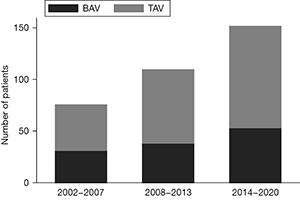Surgery for endocarditis in patients with bicuspid aortic valves
Abstract
Background: The objective of this study is to investigate clinical outcomes in patients with bicuspid aortic valves (BAV) after surgical treatment for endocarditis.
Methods: This was a population-based, observational cohort study, conducted on all patients who received aortic valve surgery for native or prosthetic valve endocarditis at Karolinska University Hospital between 2002–2020. Baseline characteristics and postoperative complications were collected from the institutional surgical database and patient medical charts. The primary endpoint was all-cause mortality. We used unadjusted and adjusted Cox regression to determine the association between valve morphology and long-term mortality.
Results: Of the 338 patients, 122 (36%) had a BAV and 216 (64%) had a tricuspid aortic valve (TAV). The mean follow-up was 5.8 years (maximum 18.4 years). Survival rates at one, five, ten and 14 years were 88%, 81%, 78% and 76% versus 85%, 69%, 58% and 43%, in BAV and TAV patients, respectively [adjusted hazard ratio (HR) 0.64; 95% confidence interval (CI): 0.39–1.05]. In patients with native valve endocarditis, those with BAV had lower all-cause mortality compared to those with TAV (adjusted HR 0.44; 95% CI: 0.22–0.89), despite having a higher prevalence of perivalvular abscess (40% versus 22%, respectively, in BAV and TAV patients). In patients with prosthetic valve endocarditis, original valve morphology did not affect all-cause mortality (adjusted HR 1.94; 95% CI: 0.64–5.87).
Conclusions: In patients with native valve endocarditis, a BAV was associated with improved survival after surgical treatment. In patients with prosthetic valve endocarditis, survival was not affected by the original valve morphology of the patient.
Cover






